Create an Amazon Business Account

Try Amazon Fresh
Introduction
|
From Kimpo to the Yalu
The Naval Air War in Korea
|
The years
immediately following World War II marked a time of transition for naval
aviation. Indeed, with dwindling defense budgets and a bitter interservice
rivalry with the upstart United States Air Force over the employment of the
nation’s air power, the very existence of sea-based air power was seriously
questioned. Strategic bombing employing the atomic bomb in the minds of many had
supplanted the Navy as the nation’s first line of defense, and minimized the
importance of tactical aviation. Such was the severity of the situation that by
mid-1950, a carrier fleet that numbered 98 at the end of World War II,
encompassed fifteen flattops.
In the early
morning hours of 25 June 1950, North Korean tanks and troops stormed across the
38th Parallel into North Korea in a sudden attack that took the world by
surprise. In keeping with a subsequent resolution by the United Nations Security
Council, President Harry S. Truman committed U.S. military forces to battle, and
on July 3rd Valley Forge, in concert with the British carrier HMS
Triumph, launched the first naval air strikes of the war, attacking
facilities at Pyongyang. In this engagement, U.S. Navy F9F-2 Panthers
scored naval aviation’s first jet kills, shooting down two North Korean Yak-9
aircraft.
In the ensuing
months, which included General of the Army Douglas MacArthur’s brilliant
amphibious assault at Inchon and drive up the Korean peninsula, through the
eventual withdrawal and settlement into a stalemate, U.S. naval aviation made a
significant contribution to military operations in Korea. By July-1953, when the
cease-fire was signed, U.S. Navy and Marine Corps aircraft had logged 189,495
attack sorties, jets had successfully demonstrated their value in combat, and
the helicopter had come of age as a transport and search and rescue platform.
Most importantly, the aircraft carrier had demonstrated its value as a flexible
platform for power projection in a limited war, a role that continues to this
day.
|
The
carriers of Task Force 77 bore the brunt of naval aviation’s air effort in
Korea. At any given time three fleet carriers operated in the Sea of
Japan, launching offensive air strikes into North Korea. |
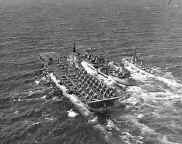 |
|
USS
Princeton (CV-37), pictured here coming alongside a tanker in July
1951, completed three combat cruises during the war. |
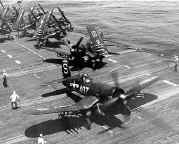 |
|
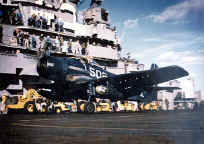 |
|
Though the
Korean War marked the dawn of the jet age in aerial combat,
propeller-driven aircraft like the F4U Corsair and AD
Skyraider logged 75% of all offensive sorties flown by carrier
aircraft. The Corsair lived-up to its World War II reputation as a
tremendous close-air-support platform, while the "Able Dog" demonstrated
its versatility in supporting troops or knocking out significant targets.
In the latter mission it was greatly aided by the fact that it could carry
as much ordnance as a B-17 Flying Fortress. Pictured here is
rocket-armed F4U-4B of VF-54 and a brilliant color image of an AD-4 of
VA-55. Both aircraft flew from USS Valley Forge (CV-45) during
1950. |
| Click On Photographs To Enlarge
|
|
During
World War II, Lieutenant Colonel Gregory Boyington’s VMF-214 "Blacksheep"
achieved lasting fame because of their skill in shooting down Japanese
aircraft. In Korea, their successors operated from the deck of the escort
carrier USS Sicily (CVE-118) with great success attacking not enemy
bandits, but positions on the ground. Entering combat in August 1950, the
"Blacksheep" and pilots of VMF-323 off USS Badoeng Strait (CVE-116)
logged 6,575 combat flight hours that month in support of Marine ground
forces defending the Pusan Perimeter. They also supported General Douglas
MacArthur’s epic amphibious assault at Inchon. |
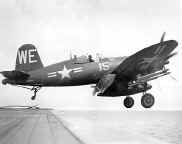 |
|
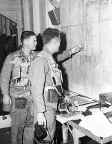 |
|
An F4U-4B of
VMF-214 is slung off the bow of USS Sicily (CVE-118) for a close
air support mission over the Pusan Perimeter. Note the HVARs slung beneath
the wings and the mission markings forward of the
cockpit. |
|
"Blacksheep" pilot Ken Reusser shows
squadron skipper, Major Robert P. Keller, the location of a "jackpot"
target in the ready room on board USS Sicily, 4 August 1950. Note
the pilots are wearing Marine utilities in lieu of flight
suits.
|
Click On Photographs To Enlarge
| |
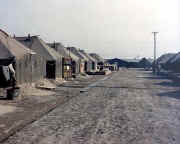 |
|
Life at one
of the many airfields scattered throughout South Korea was primitive to
say the least, as evidenced by this photograph of VMF-323’s living area at
K-1, Pusan, South Korea,
1951. |
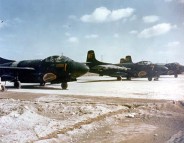 |
|
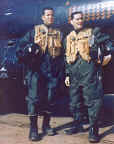 |
|
The "Flying
Nightmares" of VMF(N)-513 employed a variety of aircraft in the night
fighting role, including the F3D-2 Skyknight, an ungainly looking
jet that featured four 20-millimeter cannon and three radars. Given the
nocturnal environment in which they operated, squadron aircraft were
painted black and marked with red numerals and lettering.
|
|
Major
Elswin P. Dunn (l) and Master Sergeant Lawrence J. Fortin pictured next to
their F3D-2 in January 1953. Note the night mission markings and the red
star signifying a night kill of an enemy MiG-15 on 12 January
1953. |

Return To Main Page: The Air War Over Korea










